... newer stories
Montag, 1. Juli 2019
Meteorological report for June (Maribor)
beekids, 16:51h
We could say that the weather turned around, when we compare June to May. Even in relation to last June, this time was completely reversed. Last year a lot of precipitation, this year's heat.
The difference between the highest (27th June) and the lowest (7th June) measured temperature in the month was as high as 22.9 °C.
The average monthly temperature was considerably higher than the average of the period from 1981 to 2010, it was 22.41 °C and it was 3.41 °C higher than the long-term average. The long-term average for June is 19,0 °C in Maribor. The average temperature was quite constant throughout the month. The difference between the average temperature of the coldest (23th June) and the warmest (27th June) day was as high as 7.99 °C. There were also great differences between night and day temperatures, even above 16 °C.
In June, the daily average temperature was only once below the average of the period from 1981 to 2010 (19.0 °C). The maximum temperature was above 20 °C all days, thereof twenty-five days above 25 °C, and thirteen days even above 30 °C. In June we had two heat waves in Maribor (the temperature must be at least three days above 30 °C). The first heat wave lasted for a whole week. The lowest temperature in June was 12.9 °C, and the highest temperature was 35.8 °C. In the first six months, the average temperature was 1.14 ° C higher than the long-term average. According to the ARSO measurement method, which is official for the whole of Europe (measurements at 7, 14 and 21 hours) was 0.87 °C higher.
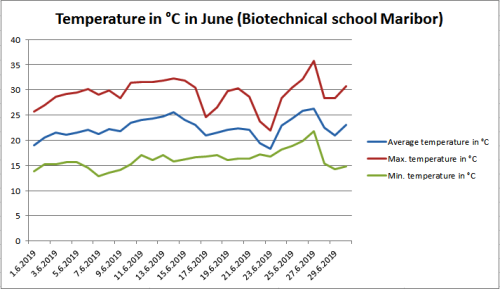
Precipitation data show that there was much less precipitation in June than in May. In June, half of the precipitation dropped, as in May, but also less than as the long-term average. The measuring device detected 73.6 mm of precipitation, which is much less as long as the long-term average (107 mm precipitation). In the first six months, 21.8 mm more precipitation fell than the long-term average.
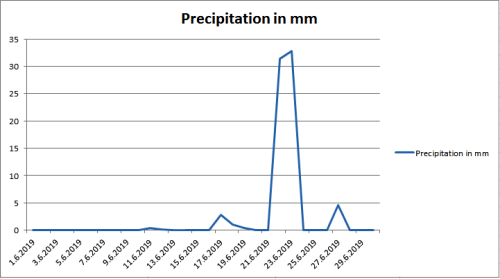
The average relative humidity in June was 68.98 %, which is less than in May and similar to 2018 (70.86 %). Given the less precipitation, this was expected.
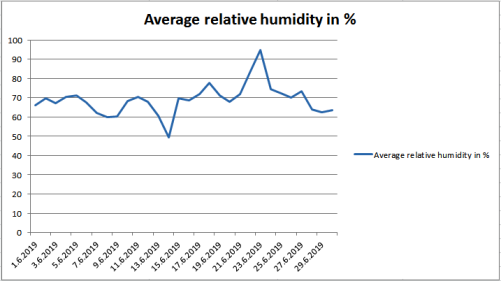
The difference between the highest (27th June) and the lowest (7th June) measured temperature in the month was as high as 22.9 °C.
The average monthly temperature was considerably higher than the average of the period from 1981 to 2010, it was 22.41 °C and it was 3.41 °C higher than the long-term average. The long-term average for June is 19,0 °C in Maribor. The average temperature was quite constant throughout the month. The difference between the average temperature of the coldest (23th June) and the warmest (27th June) day was as high as 7.99 °C. There were also great differences between night and day temperatures, even above 16 °C.
In June, the daily average temperature was only once below the average of the period from 1981 to 2010 (19.0 °C). The maximum temperature was above 20 °C all days, thereof twenty-five days above 25 °C, and thirteen days even above 30 °C. In June we had two heat waves in Maribor (the temperature must be at least three days above 30 °C). The first heat wave lasted for a whole week. The lowest temperature in June was 12.9 °C, and the highest temperature was 35.8 °C. In the first six months, the average temperature was 1.14 ° C higher than the long-term average. According to the ARSO measurement method, which is official for the whole of Europe (measurements at 7, 14 and 21 hours) was 0.87 °C higher.

Precipitation data show that there was much less precipitation in June than in May. In June, half of the precipitation dropped, as in May, but also less than as the long-term average. The measuring device detected 73.6 mm of precipitation, which is much less as long as the long-term average (107 mm precipitation). In the first six months, 21.8 mm more precipitation fell than the long-term average.

The average relative humidity in June was 68.98 %, which is less than in May and similar to 2018 (70.86 %). Given the less precipitation, this was expected.

... link (0 Kommentare) ... comment
Meteorological report for May (Maribor)
beekids, 13:30h
Was it May or April? This could be asked in terms of large amounts of precipitation. However, the temperatures were low compared to the long-term average. The difference between the highest (26th May) and the lowest (8th May) measured temperature in the month was 24.2 °C.
The average monthly temperature was lower than the average of the period from 1981 to 2010, it was 12.76 °C and it was 3.04 °C lower than the long-term average. The long-term average for May is 15.8 °C in Maribor.
In May, the daily average temperature was only seven times above the long-term average (15.8 °C). The maximum temperature was eleven times above 20 °C, thereof only two days above 25 °C. The lowest temperature in May was 1.9 °C and the highest temperature was 26.1 °C. In the first five months, the average temperature was 0.69 °C higher than the long-term average. According to ARSO, the measurement method, which is official for the whole of Europe (measurements at 7, 14 and 21 hours), was 0,43 °C higher.
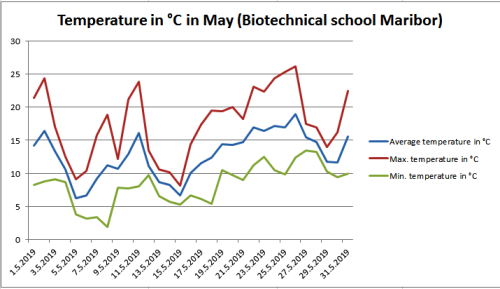
Precipitation during May was very rich with rain. In May, there were twice as much rainfall as the long-term average. The measuring device detected 158.4 mm of precipitation, which is more as long as the long-term average (83 mm precipitation). In the first five months, was 55.2 mm more precipitation than the long-term average.

The average relative humidity in May was 74.50 %, which is slightly more than in April. This was expected due to much more precipitation.
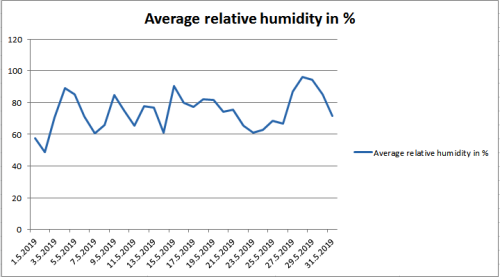
The average monthly temperature was lower than the average of the period from 1981 to 2010, it was 12.76 °C and it was 3.04 °C lower than the long-term average. The long-term average for May is 15.8 °C in Maribor.
In May, the daily average temperature was only seven times above the long-term average (15.8 °C). The maximum temperature was eleven times above 20 °C, thereof only two days above 25 °C. The lowest temperature in May was 1.9 °C and the highest temperature was 26.1 °C. In the first five months, the average temperature was 0.69 °C higher than the long-term average. According to ARSO, the measurement method, which is official for the whole of Europe (measurements at 7, 14 and 21 hours), was 0,43 °C higher.

Precipitation during May was very rich with rain. In May, there were twice as much rainfall as the long-term average. The measuring device detected 158.4 mm of precipitation, which is more as long as the long-term average (83 mm precipitation). In the first five months, was 55.2 mm more precipitation than the long-term average.

The average relative humidity in May was 74.50 %, which is slightly more than in April. This was expected due to much more precipitation.

... link (0 Kommentare) ... comment
Meteorological report for April (Maribor)
beekids, 13:14h
Finally, the normal month of this year, could be said, according to weather data. It was warm and more precipitation than in the previous three months. The difference between the highest (26th April) and the lowest (2nd April) measured temperature in the month was 23,3 °C.
The average monthly temperature was somewhat higher than the average of the period from 1981 to 2010, it was 11.41 °C and it was 0.61 °C higher than the long-term average. The long-term average for April is 10.8 °C in Maribor. However, if we compare only the average temperature of the last week of the month with the average period from 1981 to 2010, it was found that it was 3.2 °C higher.
In April, the average temperature was thirteen times below the average of the period from 1981 to 2010 (10.8 °C). The maximum temperature was seven days above 20 °C, thereof only two days above 25 °C. The lowest temperature in April was 2.2 °C and the highest temperature was 25.5 °C. In the first four months, the average temperature was 1.62 °C higher than the long-term average. According to the ARSO measurement method, which is official for the whole of Europe (measurements at 7, 14 and 21 hours), it was 1.36 °C higher.
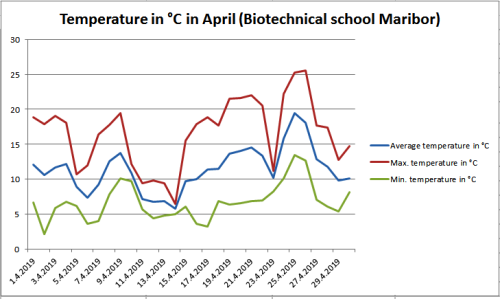
Precipitation data show that April was richer with precipitation. Precipitation during April was higher than average. The measuring device detected 79 mm precipitation, which is more than as long as the long-term average (60 mm precipitation). In the first four months was 20.2 mm less precipitation than the long-term average.
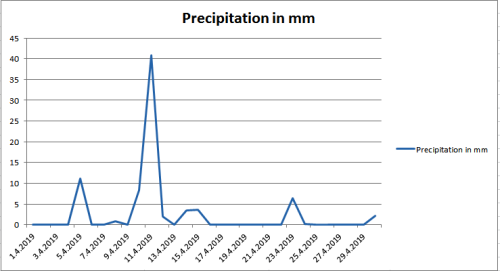
The average relative humidity in April was 70.10 %, which is slightly more than in March. Given the higher rainfall, this is expected.
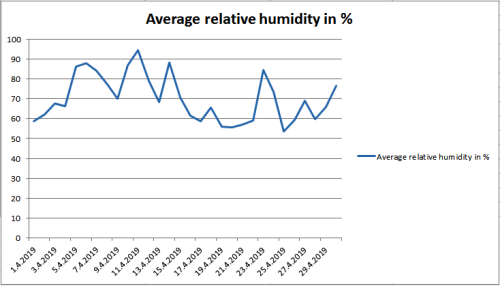
The average monthly temperature was somewhat higher than the average of the period from 1981 to 2010, it was 11.41 °C and it was 0.61 °C higher than the long-term average. The long-term average for April is 10.8 °C in Maribor. However, if we compare only the average temperature of the last week of the month with the average period from 1981 to 2010, it was found that it was 3.2 °C higher.
In April, the average temperature was thirteen times below the average of the period from 1981 to 2010 (10.8 °C). The maximum temperature was seven days above 20 °C, thereof only two days above 25 °C. The lowest temperature in April was 2.2 °C and the highest temperature was 25.5 °C. In the first four months, the average temperature was 1.62 °C higher than the long-term average. According to the ARSO measurement method, which is official for the whole of Europe (measurements at 7, 14 and 21 hours), it was 1.36 °C higher.

Precipitation data show that April was richer with precipitation. Precipitation during April was higher than average. The measuring device detected 79 mm precipitation, which is more than as long as the long-term average (60 mm precipitation). In the first four months was 20.2 mm less precipitation than the long-term average.

The average relative humidity in April was 70.10 %, which is slightly more than in March. Given the higher rainfall, this is expected.

... link (0 Kommentare) ... comment
Meteorological report for March (Maribor)
beekids, 12:59h
High temperatures continued in Maribor in March. There was also a noticeable fluctuation of temperatures, which was going on throughout the month. The difference between the highest (22nd March) and the lowest (12th March) measured temperature in the month was 24.4 °C, which is much less than the measured difference in March 2018 when it was as high as 36.1 °C.
The average monthly temperature was significantly higher than the average of the period from 1981 to 2010, it was 8,59 °C, and it was 2,59 °C higher than the long-term average. The long-term average for March is 6 °C in Maribor. By comparison, in March 2018, the average temperature was 5.24 ° C lower. In the first three months of this year, the temperatures are quite different from the previous year.
The minimum temperature was only two days below the freezing point. The lowest temperature in March was -2.4 °C and the highest temperature was 22 °C.
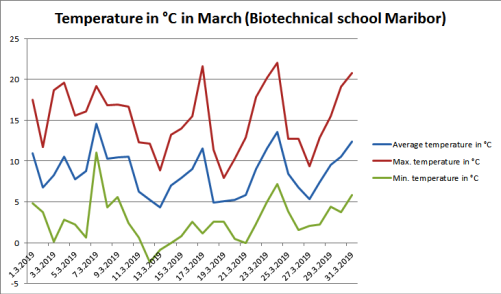
Precipitation data show that March was again below the average rainfall, as less precipitation fell than the long-standing average.
The measuring device detected 45.8 mm of precipitation, which is slightly less than the long-term average (57 mm precipitation).
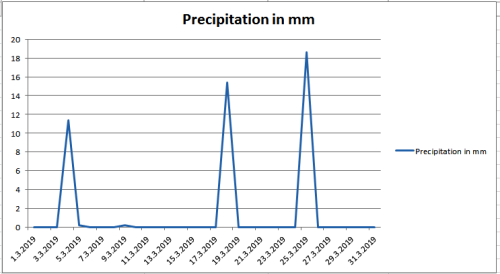
The average relative humidity in March was 63.4 %, which is not surprising given the smaller amount of precipitation.
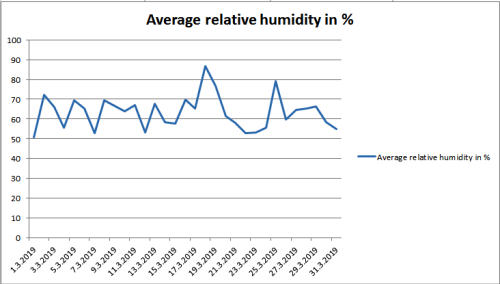
The average monthly temperature was significantly higher than the average of the period from 1981 to 2010, it was 8,59 °C, and it was 2,59 °C higher than the long-term average. The long-term average for March is 6 °C in Maribor. By comparison, in March 2018, the average temperature was 5.24 ° C lower. In the first three months of this year, the temperatures are quite different from the previous year.
The minimum temperature was only two days below the freezing point. The lowest temperature in March was -2.4 °C and the highest temperature was 22 °C.

Precipitation data show that March was again below the average rainfall, as less precipitation fell than the long-standing average.
The measuring device detected 45.8 mm of precipitation, which is slightly less than the long-term average (57 mm precipitation).

The average relative humidity in March was 63.4 %, which is not surprising given the smaller amount of precipitation.

... link (0 Kommentare) ... comment
... older stories